Assassin’s Creed III Review
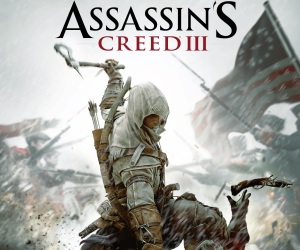 Game: Assassin’s Creed III
Game: Assassin’s Creed III
Developer: Ubisoft Montreal
Publisher: Ubisoft
Available On: Xbox 360, PlayStation 3, Windows PC
Reviewed On: Xbox 360
Three years in the making means that hopes and expectations have never been higher for an Assassin’s Creed title. Despite the very real risk that Ubisoft could be considered to be over-doing the franchise with not one, but two releases including the PlayStation Vita exclusive “Liberation”, this third proper instalment looks to cast aside the stories that have come before it, in favour of introducing a new character in the bloodline, new locations and hopefully, some new tricks.
However, has enough changed to satiate fans of the series? Is Connor’s tale one worth telling, and what of the large open world’s that greeted players of games prior; have they returned?
STORY: Continuing Desmond’s tale to save the world by introducing another of his bloodline in Connor, the Native American, is very much the order of the day here. Following such a beloved and strong character as Ezio Auditore was never going to be an easy task, but through a series of twists, Connor becomes a character the player will come to love. It’s actually rather impressive, but it appears Ubisoft have managed it again with Connor, as he’s a humble, flawed yet interesting character, despite his fairly by-the-numbers back story.
Ubisoft have managed to keep the biggest secrets about the Assassin’s Creed III story quiet to this point, and that won’t change in this review, but there’s more depth this time around, and some genuine shocks and twists that players won’t see coming. Set in Colonial America, Connor wants to defend his people from an ever-encroaching British/Templar threat, and to do so he needs to become an Assassin. Connor’s story overall is an interesting one, while the Desmond sections are never too long, but overall the player will have resolution for some of the main characters inside the Assassin’s Creed universe.
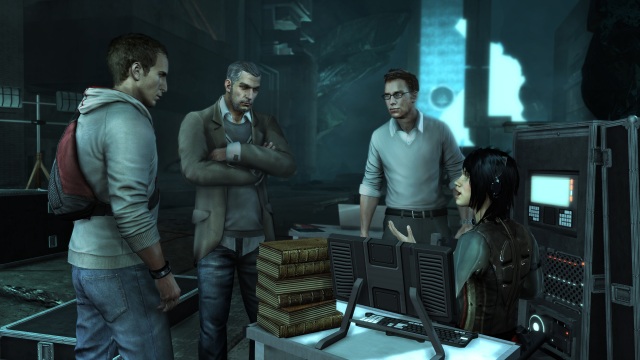
GRAPHICS: Careful attention to details are always evident when it comes to mapping out environments in the Assassin’s Creed universe, and this third title is no different. The forests are a different kind of element for these games though, and it’s actually easy enough to get a little lost and sometimes confused in the process. The trees and foliage repeat themselves in terms of style, with the trees that are climbable fairly obvious to spot. But it all looks splendid, and some early missions really show the visual flare of the development team. It’s not always draw dropping, but it’s impressive nonetheless and has its moments.
Facial animations appear to have been given a new lease of life, with Desmond’s appearance seemingly having moved back towards the earlier games, and he looks all the better for it. There are numerous cut-scenes on show, but they are mostly a joy to watch, and you’ll really begin to empathise with characters thanks to how they look. Lighting is especially impressive, with even the loading screens appearing to have a dynamic effect on them, casting light or dark on the player’s face. Shadows are excellent too, and when Connor is high atop a climbed peak, spotting his shadow being cast onto a lower rock is surprising, but fantastic. That’s not to say there aren’t any hiccups, however, and there is the odd graphical oddity or glitch that has become the norm for open world titles of this magnitude, but aside from the scenes with Desmond and Co. travelling in the van (which will no doubt be the butt of a lot of jokes) the game looks lovely.
SOUND: An area where Assassin’s Creed III truly shines is the audio design. The volume of dialogue on display must have taken some real effort, with every accent in the English lexicon catered for at some point or another. Couple this with some genuinely convincing and emotive performances, and you’ve got a believable game in your hands. The native tongue is represented well too, with subtitles inviting the player into conversations they might not otherwise understand. However, the best part is how well the voice acting is represented visually; the character lip-syncing is phenomenal. Given how much of the spoken word the player will have to hear, it’s an obvious decision to pay careful attention to this, but it really has been successfully executed. The only real flaw is that despite a huge bank of audio to draw from, in some areas there are only a few samples of dialogue for certain things, for example during the Naval sections.
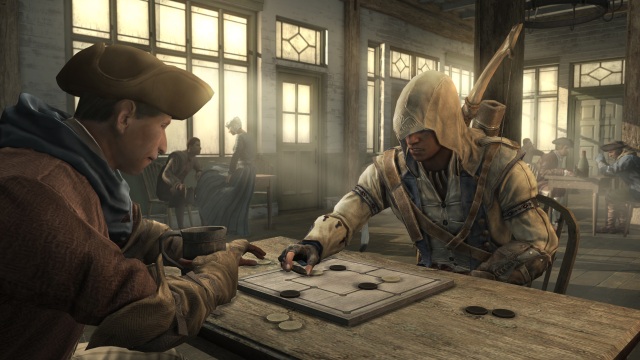
The world of Assassin’s Creed III is alive too, and not just through the sweeping, gorgeous soundtrack that accompanies much of the cinematic moments, but the forests will fall silent as Connor sneaks around them, only to hear a startled deer dash from the bushes, or fall to a trap that had had be laid previously. In towns, the chatter is a constant buzz, and you’ll never be able to listen in to it all. You may have a mission to carry out, but the world around you continues to live and breath; it’s very impressive.
GAMEPLAY: Starting very slowly, players are taught how every main mechanic in the game works, which is fantastic for newcomers to the series, but for returning players, it can feel as though they are literally wandering from one cut-scene to another at times. Traversal can take a while too, until – just like in previous games – you unlock fast travel options, but early missions bring to mind sections from the very first title, which require you to mount a horse and plod along from point A to point B, meaning that traversal, at times, isn’t a lot of fun outside of the main story missions. Unfortunately, the game isn’t that great at communicating how you travel from region to region, but once you realise you can zoom out of the map, then zoom in to the mission area, then fast travel to the nearest location, it makes things far easier to get around.
Without a doubt, Ubisoft Montreal have created an absolutely huge and impressive game-world, but despite the interesting back-stories and genuinely likeable characters, the problem is that, although full of content, a lot of it isn’t actually all that fun. The hunting is interesting to begin with, as Connor is able to use clues and instinct to track animals, before laying traps in locations they may return to. Furthermore, you can hide in the bushes and drop bait for the animals, before killing and skinning them; you can even air-assassinate the animals. However, ultimately, it feels as though even the development team know that it wears out its welcome, as after you press the button to skin the animal, you can skip the short cut-scene that follows, which you will do without fail, every single time after you realise you can; it feels very much like Red Dead Redemption in these moments.
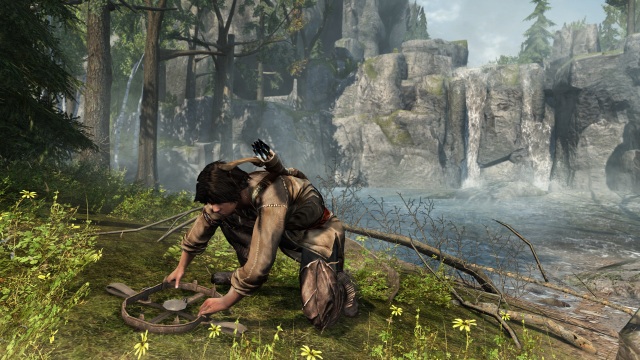
In Assassin’s Creed II: Revelations, the marmite effect of the tower-defence styled brotherhood games has been removed, replaced with other new mechanics, including an upgraded management system that allows you to buy, sell and trade goods. For example, you can purchase goods and make a profit on them by sending them off for trade, taking into account a risk/reward system. It’s a nice distraction, but it’s not particularly fun. Likewise, the new board-game style efforts are just not fun, and it’s baffling as to why they are even there. Sure, there needs to be things to do in an open-world environment, but it’s unlikely that a fan of the core Assassin’s Creed gameplay comes to the series for a version of Draughts. I’m all for adding value to a game, but it needs to engage the player. The brotherhood is present too, and you can assassinate guards or cause disruption to the peace with a simple tap of the left bumper. You can also still recruit new members to the brotherhood, and send them away on missions, much as you could in previous games.
The inclusion of Naval combat is also a fascinating one, and graphically there are some splendid moments, as the wind changes your course and you fight back against it, the sun casting shadows upon the deck as your crew dash about following your orders. It’s actually quite fun attacking and defending against other ships, but in a clever design choice, you are only forced to take part in a few of these missions. There’s a whole sub-series of missions that are optional if you do enjoy them though, with all the bonuses you’d expect from taking part in them too.
Assassin’s Creed III can suffer from a lot of loading at times, though there is at least variety in the loading screen visuals you’ll see, depending on what you’re doing at the time. The problem is exacerbated when you load into a cut-scene, watch it, leave a room only to be met with another loading screen. Expect to get used to seeing story cut-scenes too, as there are an absolute boat load of them, with some missions really only requiring the player to walk from point A to point B to see a story-beat.

The core mechanics of being an assassin have been honed over the series to give the most satisfying combat to date. You’ll never feel locked in to a battle now, and at any time you can turn tail and run away. The counter system is fantastic, if you time it right you can immediately follow-up a block with a variety of return attacks, you can simply disarm the enemy, throw them out of the way or straight up kill them depending on which button you press following the counter. There are some magnificently executed attacks and you can really get into a free-flowing set of combos that will see Connor attack multiple enemies, it’s a joy to behold, but at times there’s just so much of it, especially when compared to the stealthy appearance of the previous games.
It’s worth pointing out that the first four or five hours are quite linear, which is perhaps to be expected as a brand new character and time-period is being introduced. Around Sequence 6 the game starts to open up though, and if you are so inclined, you can start to do all manner of the aforementioned side-quests. The biggest concern though is how the game stops you feeling like a badass assassin, there are some assassinations where control is taken from the player, instead replaced with a cut-scene. Indeed, one of the pivotal kills in the game is one you watch, rather than act out. There are numerous main-story missions that might eventually end up with an assassination, but the preceding missions will see Connor following another character on a horse, on foot, or even on the rooftops. Sadly, the mission design just isn’t as stellar as it could be.
MULTIPLAYER: Contained on a separate disc, the Assassin’s Creed III multiplayer continues where the previous games left off. It’s funny to think that despite being a game series that most people would argue doesn’t need any multiplayer, the Assassin’s Creed multiplayer experience has ended up being something unique and enjoyable. Returning with new modes in Domination and Wolf-Pack survival, it’s good to see genuine iteration, instead of repetition. There’s plenty of customization to how your character looks and feels, and despite the modes being fairly by-the-numbers, they remain fun and engaging and not just a distraction. The lack of variety in the multiplayer arena these days (shooters, shooters and more shooters) means that Assassin’s Creed III, like its forefathers, is a worthy addition to the package, adding not just additional content for your money, but fun content too.
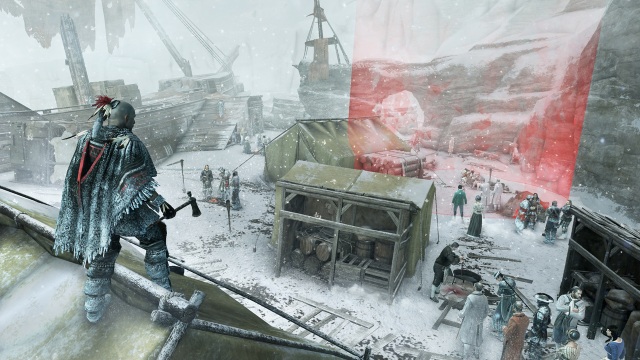
LONGEVITY: As usual, you can expect to get around 30 or more hours from Assassin’s Creed III, with multiplayer modes adding yet more value. The story can be mainlined in nearer 10-15 hours though (that’s if you ignore most of the side-missions), so how much time you’ll get out of the game is down to how much you enjoy the additional open-world content, as well as the Naval missions too. Fans of the series are used to spending a great deal of time in the worlds that Ubisoft create, and the third instalment is the biggest to date, no question.
VERDICT: Assassin’s Creed III isn’t a bad game, but it does feel a little unfocused at times due to the sheer scope of the game world. If you are a die-hard fan then you’ll probably enjoy what it has to offer, but for others, despite the new engine being impressive, there was perhaps a greater need to self edit this time around on Ubisoft’s part, and in some cases to take another look at the direction.
Connor’s story is an interesting and engaging one that is well worth playing, but this absolutely huge world that has been laid bare for the player just feels a little devoid of any truly engaging content outside of the main story missions, and too often the player is just going from A to B to see a new cut-scene. All the things you’d expect from an Assassin’s Creed title are here and there’s still fun to be had, but the new features and design decisions leave the player cold.





